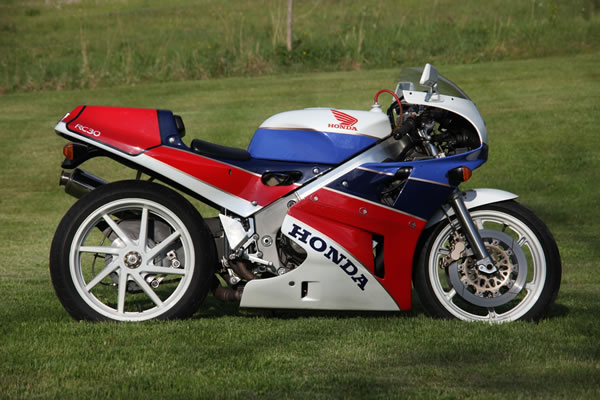
small image library medium image library large image library
|
| 33 images of this bike are available by clicking: small image library medium image library large image library |
And now we present a 1990 Honda RC30 in original mint condition. The Honda RC30 goes beyond cult status. It is a legend. There is no other bike on the planet that means so much and so rapidly reduces normal riders to gibbering wrecks at the thought of owning one.
Hand-assembled by a team of four at HRC (Honda Racing Corporation), the RC30 is powered by a 748cc, liquid-cooled, four stroke, carbureted v-four engine that makes 94bhp at 11,300, and 47 lb-ft of torque at 9,800 rpm.
The RC30, otherwise known as the VFR750R, was the homologation bike that Honda sold for the Formula 1 and World Superbike Championships. This was the first race-replica that was also a real racer. The RC30 cost twice as much as the VFR750, and any relationship to a VFR750 ends on the other side of "R".
Each RC30 was hand assembled by a special four man team at HRC. Each weld is perfect. The craftsmanship is evident in how each component of the bike is put together, the magnificent finish, and the virutes of a factory balanced and blueprinted engine. The RC30's history can be summed up in its performance features. That it was manufactured in the first place is as significant as the dominating success it attained at the highest levels of racing.
The single sided endurance race swingarm is identical to the one used on Wayne Gardner's Suzuka 8 hour endurance racer, with an outboard sprocket, an inboard disc, and a single nut retaining the wheel. The RC30 had a thicker frame than the VFR750, crafted from aluminum, and still weighs 77 lbs less. The bike's geometry was based on the factory F1 racer. The lightweight aluminum tank is the first that Honda had ever put on a production bike since the Elsinore of the 1970s. The lightweight, thin fiberglass fairings were hand-laid at HRC. Even the twin curved radiators were crafted from aluminum to save weight. Lightweight racing wheels compliment the Showa suspension.
It is the engine however, where Honda put its mark, and this is the bike that put its mark on several World Championships. Fred Merkel and the RC30 dominated the World Superbike Championship in 1988 and 1989. Carl Foggarty made his mark with the RC30 on F1 in 1989 and 1990, and won the 1990 Isle of Man TT. The RC30 ridden by both Joey Dunlop and Steve Hislop would shatter records in the Isle of Man TT. In fact, the RC30 would remain competitive in the Isle of Man TT well into the late 1990s. And the RC30, in the hand of privateers all over the USA would dominate local racing club events. The RC30 is a production bike, however, it is a homogolation bike. Honda decided to make 300 of them so they could dominate production level racing. A few years later, Yamaha and Suzuki would follow with their own homogolation specials.
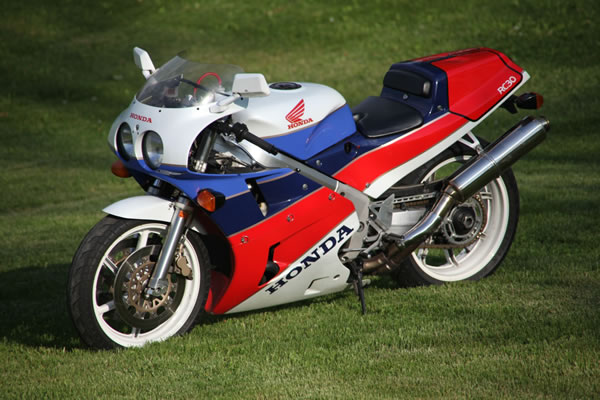 The RC30 engine includes components that are remarkable even for today. The connecting rods are titanium, designed to be lightweight (so Honda could use them in World Superbike), but also by reducing reciprocating weight, and therefore vibration, the RC30 is one of the smoothest running V-fours, and allows the big end bearings to live easily at the 12,500 rpm redline. Probably, the most significant change in the engine is the redesigned heads that include bucket tappets rather than rocker arms, again reducing reciprocating weight and vibration, and allowing the valve-train to have greater reliability at the 12,500 redline. The compact head design allowed for straighter, better-flowing ports.
The RC30 engine includes components that are remarkable even for today. The connecting rods are titanium, designed to be lightweight (so Honda could use them in World Superbike), but also by reducing reciprocating weight, and therefore vibration, the RC30 is one of the smoothest running V-fours, and allows the big end bearings to live easily at the 12,500 rpm redline. Probably, the most significant change in the engine is the redesigned heads that include bucket tappets rather than rocker arms, again reducing reciprocating weight and vibration, and allowing the valve-train to have greater reliability at the 12,500 redline. The compact head design allowed for straighter, better-flowing ports.
The four carburetors are high-flowing, constant velocity 38mm Keihins CVs, huge for a 750. A 360 degree crankshaft borrowed straight from Honda's factory racing F1s delivers a flat, droning exhaust note. It is the 360 degree camshaft rather than the 180 degree camshaft of the VFR750, that allowed Honda to tune this engine to such a degree. There may be nothing quite like the sound the RC30 delivers, especially high up in its rev range. The simple act of starting up the RC30, bringing it to temperature, and then running it through its gears has been described as a symphony. The four, into two, into one exhaust system intricately winds its way around the engine and peeks from behind the fairings, showing off its quality welds at the same time.
The RC30 is a street-legal factory racer. The Showa shocks and forks are fully adjustable. The foot pegs are higher up and further back than typical for most sportbikes. The handlebars are genuine low clip-ons. The rider sits far to the front of the machine, with its short gas tank. Make no mistake, the RC30 is meant to be ridden on race tracks or twisty roads, and it won't be comfortable around town. Even with its two massive radiators, the legendary heat that pours from the vents on the right side will guarantee you will not want to sit in stop and go traffic. The gearbox is pure racetrack with its super tall 1st gear. HRC designed the front forks with fast-release axles, and installed a steering damper. The RC30, remains to this day, as close to a real factory racer as possible.
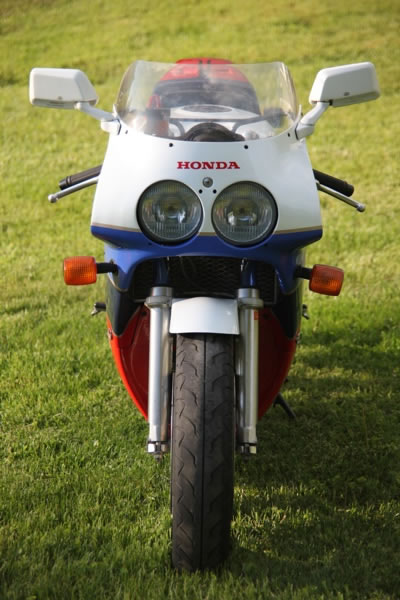
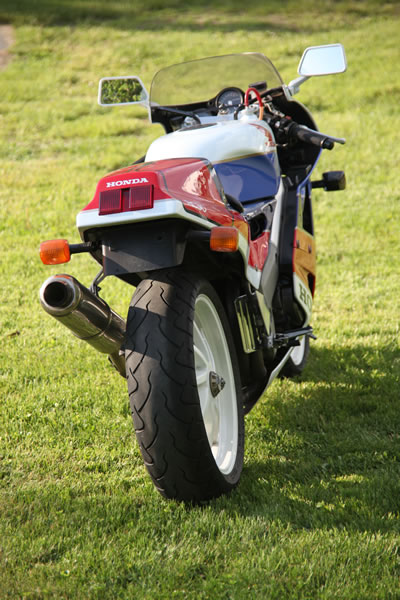 Original RC30s are rare and hard to find in this condition. Only a total of 300 RC30s were ever imported into the USA. They were too expensive for the average rider (twice the cost of a VFR750), and most saw competition. Of those few put on the street, many have long since been outfitted with a smaller rear wheel conversion and aftermarket parts. No one knows exactly how many RC30s remain in existance. What is known is that they rarely come up for sale, mostly because owners are reluctant to give up such a motorcycle icon.
Original RC30s are rare and hard to find in this condition. Only a total of 300 RC30s were ever imported into the USA. They were too expensive for the average rider (twice the cost of a VFR750), and most saw competition. Of those few put on the street, many have long since been outfitted with a smaller rear wheel conversion and aftermarket parts. No one knows exactly how many RC30s remain in existance. What is known is that they rarely come up for sale, mostly because owners are reluctant to give up such a motorcycle icon.
This particular RC30 remains completely unmolested. It still has its distinctive 18" rear wheel. Even the front brake rotors with the factory cuts are the originals (extremely hard to find). In the keyed compartment behind the seat rest is the original Honda canvas rolled toolkit. The original manual still exists. The bike has not been painted, nor does it show any sign of crash or "fall over" damage. The tell-tale sign of HRC original body work is using one's fingers to feel the roll of the lip of the hand-laid fiberglass. That lip is present everywhere, as is the seemingly impossible-to-be-that-thin wall of the fiberglass panels. This is not an RC30 which has ever seen the ground.
What sets this RC30 apart, besides its immaculate condition, is that it has been ridden by its first owner, and continued to be ridden by its second (present) owner. With more than 15,000 reliable miles on the odometer, this bike is intended to continue to be ridden with confidence by its next owner.
This bike has not been detailed; yet is in immaculate condition. This bike has never been ridden in poor weather, has only been stored in a heated garage, and winterized including the draining of gas from the tank and carburetors. As a result of meticulous mechanical care from its adult owner, this bike is able to start with a single push of the electric start button. The bike has never been operated without the engine first being brought to operating temperature.
The RC30 has enormous reserves of tractable power. This is not a pipey modern "crotch rocket" that is difficult to enjoy below its powerband. To the contrary, this RC30 does not mind being motored at 6,000 rpm and will wind steadily to its redline. It loves to rev to its redline. In fact, with no steps or flat spots in its power delivery, it's hard to say where the serious power begins. Above 7,500 rpm, if the throttle is turned the power climbs quickly and the gears need to be shifted quickly. Speed ensues quickly - but it does not have the desperate feel of a bike trying to climb to 150+. It simply arrives there smoothly and with little bother.
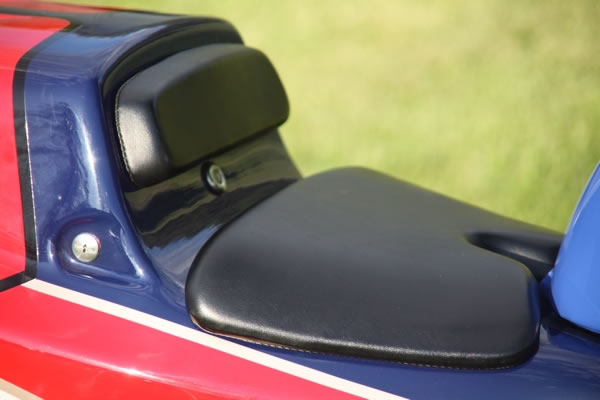 Unlike a VFR750, the RC30's dimensions are closer to that of a 500cc MotoGP bike. Its wheelbase is a short 55.5 inches, and sitting on the bike feels more like riding on top a roomier Honda RS250R. The thin pad of the RC30 however, is deceptive. It is much more comfortable than its racer look.
Unlike a VFR750, the RC30's dimensions are closer to that of a 500cc MotoGP bike. Its wheelbase is a short 55.5 inches, and sitting on the bike feels more like riding on top a roomier Honda RS250R. The thin pad of the RC30 however, is deceptive. It is much more comfortable than its racer look.
This RC30 is the best handling bike I have ever been on when the twisties get bumpy - comparing it to a Bimota V-Due, a Triumph 675, a Ducati M900, and a BMW R1100R. It is possible to move far forward over the front wheel to keep it planted, and to slide rearwards to keep the rear tire from spinning up exiting turns. But, its also comfortable for upright sitting when slowing down for village centers. I rode this bike solely on mountain roads between Vermont and New Hampshire. This bike is incredibly comfortable for long spirited rides of four hours and more.
The exhaust note is worth mentioning. The drone it produces when it is winding out through its upper rpm range is one of the most memorable exhaust sounds. There simply is no other bike that can imitate the RC30's combination of four into two into one exhaust system paired with a 360 degree crankshaft. Riding low to the tank allows the rider to duck under the wind turbulence and permits the massive and throaty intake noise from the four carburetors mounted high up under the lightweight tank to make their presence heard. The combination of intake and exhaust is alone worth the cost of ownership of this truly inspired machine.
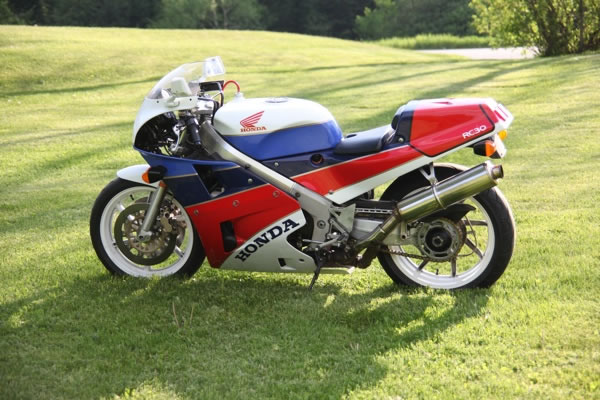 The bike is small and nimble for a 750 and feels even lighter than its 407 lbs. The suspension is extremely well planted and inspires confidence in cornering.
The bike is small and nimble for a 750 and feels even lighter than its 407 lbs. The suspension is extremely well planted and inspires confidence in cornering.
The gearbox is smooth shifting, and the mirrors are worth noting. They simply do not make rear view mirrors today that are actually functional. These have a great field of vision, yet fold conveniently for storing in tight spaces, or for reducing the wind drag when what is happening behind you is of no consequence.
The only difficulty I have encountered in owning this bike is that of parking it without engaging in endless conversations with gawkers about "so and so who used to race one at Loudon" or how someone "has always wanted to see one of these for real." The RC30 is perhaps the most recognizable exotic. This bike is extremely clean, and well-cared for. There are no mechanical issues with this bike. It is ready to continue being enjoyed, or detailed and put into collection.
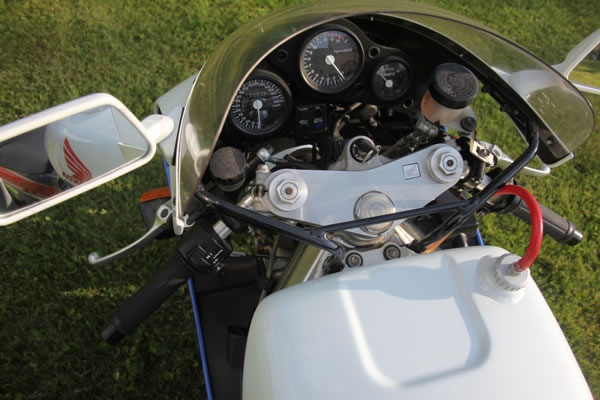 While 100% original, this bike is not without the minor defects. The lower panels are exhibiting a phenomena that is associated with the hand-laid HRC fiberglass bodywork. The panels at some time in their history bubbled under the original paint. The phenomena is known as moisture osmosis and has been documented on the RC30 Users Group. I purchased this bike with the bodywork as is, and it is my understanding at the time that the phenomena is a one-time issue. That certainly has proven the case since my ownership from 2007.
While 100% original, this bike is not without the minor defects. The lower panels are exhibiting a phenomena that is associated with the hand-laid HRC fiberglass bodywork. The panels at some time in their history bubbled under the original paint. The phenomena is known as moisture osmosis and has been documented on the RC30 Users Group. I purchased this bike with the bodywork as is, and it is my understanding at the time that the phenomena is a one-time issue. That certainly has proven the case since my ownership from 2007.
Repainting an original bodywork is out of the question in my opinion. The patina of original paint that looks this bright and new is more important. The bubbling is unnoticeable from a short distance, but has been attenuated with direct lighting in the photographs so that it is clearly evident to the Buyer. Some consider bubbling common on RC30s and an indication that the bike has neither been repainted, nor ever crashed in its history.
With a minor detailing this bike is ready to become a living room sculpture. However, the best value of this bike is that not only is it incredibly gorgeous and rare, but that this particular RC30 is road worthy and ready to continue to ride long-term.
VIN# JH2RC3002LM200057
15,485 miles
Location: Vermont
Priced at US$24,000.00
Shipment must be arranged and paid for by Buyer. Seller is willing to assist in arrangements. Contact the owner by email by clicking here.
33 images of this bike are available by clicking:
small image library medium image library large image library
Additional bikes of interest for sale by Owner are 1974 MotoGuzzi 850-T custom cafe, 1999 Ducati M900 custom cafe, 1999 immaculate HRC RS250R, 1999 original Aprilia RS250 Challenge Cup in mint condition. Bikes already sold by Owner are Bimota V-Due 500.
This 1990 promotional video by Honda shows the RC30 being hand assembled, and run on a track adjacent to the factory F1 Honda. The RC30 is built in the same facility that produces Honda's factory racers. The RC30 is a street legal factory racer, built in a limited edition so that Honda could claim it was a production bike. It went on to dominate World Superbike and F1.